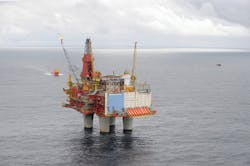DEA, Statoil commit to Dvalin tieback
DEA has jogged Norway’s sluggish development sector into life by awarding contracts for its $1.23-billion Dvalin project in the Norwegian Sea. The company discovered the gas/condensate field, formerly known as Zidane, in 2010, then twice applied for extensions to the license to devise ways of lowering the project’s cost. Negotiations with Statoil on a subsea tieback to the Heidrun platform also took time, but the TLP will be the host facility, with production due to start in 2020.
Dvalin, 15 km (9.3 mi) northwest of Heidrun, contains an estimated 18.2 bcm of gas from two reservoirs. Aker Solutions performed front-end engineering and design for the tie-in and modifications to Heidrun. Aker will also manufacture the subsea production system which will comprise a manifold/template, four subsea trees, and a control umbilical linked to the platform. The contract includes maintenance of the equipment, plus options for further tieback connections to Heidrun.
Two of Technip’s reel-lay vessels will install the pipelines, umbilical, riser bases, and other modules during 2018-19. Aibel will construct a new 4,000-ton gas treatment module and a 400-ton injection system to be installed on the Heidrun TLP over the same period, with Statoil executing the associated topsides modifications. At Heidrun the gas will be part-processed before being sent through a connection to the new Polarled pipeline in the northern Norwegian Sea, laid by Allseas last year, to the onshore terminal at Nyhamna that handles gas from the Ormen Lange field. Heidrun’s own gas heads through the Åsgard Transport System, but capacity in this line is fully occupied - another reason why development of Dvalin, along with other gas fields in this area, has been delayed.
Before year-end Aker BP, the new company combining the Norwegian assets of BP and Det norske oljeselskap, will likely approve a subsea tieback of the Centrica-operated Oda (ex-Butch) field to the Ula platform in the southern Norwegian North Sea. This follows a recent transaction with Tullow Norge for a package of field interests that included 15% of Oda.
Outlook bleak for UK offshore investment
Measures to sustain offshore activity on the UK continental shelf have been partly successful with the cost of extracting a barrel of oil or gas across the sector nearly halved since 2014, according to Oil & Gas UK’s latest Economic Report. Over the same period production has risen by 10%, although this was due to start-up of various major new development projects.
On the downside, the UK supply chain’s revenues have fallen by around 30% since 2014, the report found, with around 120,000 jobs probably lost. Deirdre Michie, the association’s chief executive, called for fresh investment and initiatives to lift the UK offshore industry. “Exploration has fallen to record lows and little new investment has been approved in 2016,” she pointed out, “and 2017 looks no better.”
The association called on the UK government to reaffirm its commitment to a more competitive, simple, and fiscal tax regime as the basin continues to mature. It also urged the Treasury to introduce measures to enable tax relief to be transferred upon the sale of an oil and gas asset - this could stimulate transactions that might extend the lives of late-life UK offshore facilities.
Some oil companies, particularly independents, are pursuing new projects in UK waters, cutting costs where possible in order to attract partners or finance. Hurricane Energy has provisionally chosen Technip and FMC Technologies as exclusive provider of subsea solutions for the Lancaster early production system (EPS) west of Shetland and other fractured basement field developments in the Greater Lancaster Area. The two contractors, Hurricane said, have devised an innovative approach to improving the economics of the EPS, focusing on optimization of system design and reduction of risk during the project’s execution. This has allowed Hurricane to downsize the scope and lower the cost of the development, ahead of a final investment decision in mid-2017. Following a recent pilot well drilled on Lancaster, the company has upgraded recoverable oil resources from the field to more than 300 MMbbl.
Bids in for latest APA round
Thirty-three companies submitted bids for Norway’s 2016 awards in pre-defined areas (APA) licensing round, 10 fewer than in 2015. According to the Norwegian Petroleum Directorate, the main interest was in the North Sea and Norwegian Sea following the award this summer of various frontier blocks in the Barents Sea under a separate license round.
Sissel Eriksen, exploration director at the Norwegian Petroleum Directorate, said the response “demonstrates that the companies…prioritize exploration in mature areas during times with challenging cost and price regimes.” The directorate will assess the geological concepts and exploration strategy in the APA bids, with license awards likely early in 2017.
Stella on brink of first oil
Ithaca Energy expects to bring its Greater Stella Area project onstream in the UK central North Sea this month. The modified semisubmersible production platformFPF-1 has been moored on location following its voyage from the Remontowa shipyard in Polamd, with Technip tidying up commissioning of the subsea systems. Following installation of a 44-km (27-mi) spurline from the platform, Ithaca should be able to route production of the Stella field’s light oil through the Norpipe system next year after an initial period of tanker offloading. Installation of the export pumps on the platform and final subsea connections should follow shortly after field start-up.
Another decade ahead for Statfjord
Production from the Statfjord field in the North Sea has passed the 5 Bboe mark. When operations started in 1979, the original aim was a recovery factor of 40%. Current partners Statoil, Centrica, and ExxonMobil have pushed the bar to 67% and are now looking to extend production through 2025.
The field was due to be shut down during the previous decade, but as elsewhere on the Norwegian shelf, the advent of new technologies progressively helped extend its productive life, with output actually rising over the past four years helped by subsurface innovations and more efficient drilling. At the same time, Statoil estimated drilling costs have come down by 50%. The major change, however, has been the transformation of Statfjord from an oil to a largely gas producer following a program to reduce reservoir pressure, which also involved extensive modifications to the three platforms.


